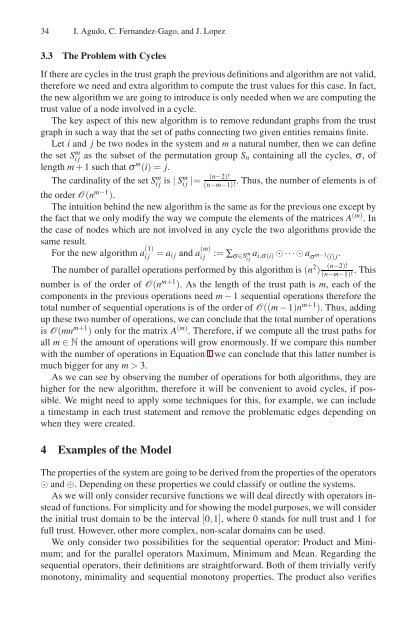Lecture Notes in Computer Science 5185
Lecture Notes in Computer Science 5185
Lecture Notes in Computer Science 5185
Create successful ePaper yourself
Turn your PDF publications into a flip-book with our unique Google optimized e-Paper software.
34 I. Agudo, C. Fernandez-Gago, and J. Lopez<br />
3.3 The Problem with Cycles<br />
If there are cycles <strong>in</strong> the trust graph the previous def<strong>in</strong>itions and algorithm are not valid,<br />
therefore we need and extra algorithm to compute the trust values for this case. In fact,<br />
the new algorithm we are go<strong>in</strong>g to <strong>in</strong>troduce is only needed when we are comput<strong>in</strong>g the<br />
trust value of a node <strong>in</strong>volved <strong>in</strong> a cycle.<br />
The key aspect of this new algorithm is to remove redundant graphs from the trust<br />
graph <strong>in</strong> such a way that the set of paths connect<strong>in</strong>g two given entities rema<strong>in</strong>s f<strong>in</strong>ite.<br />
Let i and j be two nodes <strong>in</strong> the system and m a natural number, then we can def<strong>in</strong>e<br />
the set S m ij as the subset of the permutation group Sn conta<strong>in</strong><strong>in</strong>g all the cycles, σ, of<br />
length m + 1 such that σ m (i)= j.<br />
The card<strong>in</strong>ality of the set Sm ij is | Sm (n−2)!<br />
ij |= (n−m−1)! . Thus, the number of elements is of<br />
the order O(nm−1 ).<br />
The <strong>in</strong>tuition beh<strong>in</strong>d the new algorithm is the same as for the previous one except by<br />
the fact that we only modify the way we compute the elements of the matrices A (m) .In<br />
the case of nodes which are not <strong>in</strong>volved <strong>in</strong> any cycle the two algorithms provide the<br />
same result.<br />
For the new algorithm a (1)<br />
ij = aij and a (m)<br />
ij := ∑σ∈S m ij a i,σ(i) ⊙···⊙a σ m−1 (i) j .<br />
The number of parallel operations performed by this algorithm is (n 2 ) (n−2)!<br />
(n−m−1)! .This<br />
number is of the order of O(n m+1 ). As the length of the trust path is m, each of the<br />
components <strong>in</strong> the previous operations need m − 1 sequential operations therefore the<br />
total number of sequential operations is of the order of O((m − 1)n m+1 ). Thus, add<strong>in</strong>g<br />
up these two number of operations, we can conclude that the total number of operations<br />
is O(mn m+1 ) only for the matrix A (m) . Therefore, if we compute all the trust paths for<br />
all m ∈ N the amount of operations will grow enormously. If we compare this number<br />
with the number of operations <strong>in</strong> Equation 1 we can conclude that this latter number is<br />
much bigger for any m > 3.<br />
As we can see by observ<strong>in</strong>g the number of operations for both algorithms, they are<br />
higher for the new algorithm, therefore it will be convenient to avoid cycles, if possible.<br />
We might need to apply some techniques for this, for example, we can <strong>in</strong>clude<br />
a timestamp <strong>in</strong> each trust statement and remove the problematic edges depend<strong>in</strong>g on<br />
when they were created.<br />
4 Examples of the Model<br />
The properties of the system are go<strong>in</strong>g to be derived from the properties of the operators<br />
⊙ and ⊕. Depend<strong>in</strong>g on these properties we could classify or outl<strong>in</strong>e the systems.<br />
As we will only consider recursive functions we will deal directly with operators <strong>in</strong>stead<br />
of functions. For simplicity and for show<strong>in</strong>g the model purposes, we will consider<br />
the <strong>in</strong>itial trust doma<strong>in</strong> to be the <strong>in</strong>terval [0,1], where 0 stands for null trust and 1 for<br />
full trust. However, other more complex, non-scalar doma<strong>in</strong>s can be used.<br />
We only consider two possibilities for the sequential operator: Product and M<strong>in</strong>imum;<br />
and for the parallel operators Maximum, M<strong>in</strong>imum and Mean. Regard<strong>in</strong>g the<br />
sequential operators, their def<strong>in</strong>itions are straightforward. Both of them trivially verify<br />
monotony, m<strong>in</strong>imality and sequential monotony properties. The product also verifies

















